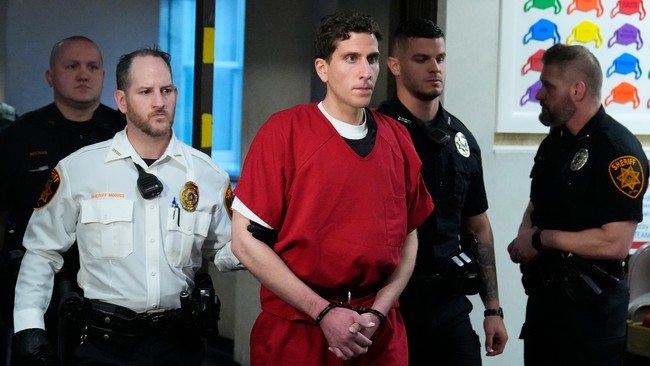Judge Rules Against Bryan Kohberger’s Effort to Suppress DNA Evidence
This post was originally published on this site

Last month, Bryan Kohberger’s attorneys attempted to have all of the evidence against him in his murder trial thrown out on the grounds that he was identified thanks to genetic genealogy techniques which were used without proper warrants.
Advertisement
DNA was found at the scene on the sheath of a knife which was discovered under one of the victim’s bodies. The FBI took that DNA and compared it to DNA on some publicly available database and found a familial match which directed them to Kohberger. Subsequently, they tracked his movements as he drove to his families home in Pennsylvania where they took trash from outside the family home and ran the trace DNA to find a match for the father of the suspect. Kohberger’s attorneys argue both searches required a warrant and because authorities never had one all of the evidence that resulted from the identification of Kohberger should be tossed out. Today the judge in the case rejected this fairly bizarre view of privacy.
A DNA technique that prosecutors said first identified Bryan Kohberger as the suspect in the University of Idaho student homicides did not jeopardize the investigation, and its use by the FBI does not justify suppressing any evidence collected after that, the judge in the high-profile murder case ruled Wednesday…
“In sum, defendant’s argument finds no support under the law,” Hippler wrote. “Any privacy interest he can claim in this DNA was abandoned along with the sheath, to which he claims no ownership or knowledge. Even if no such abandonment occurred, defendant has not demonstrated it is reasonable to recognize a privacy interest in DNA left at a crime scene.”…
“The court concludes that the search warrants are not invalid based on the omission of defendant’s identification through IGG because that information would have only bolstered probable cause for the searches,” Hippler wrote. “As to the remaining challenges, the court finds defendant has failed to carry his preliminary burden under Franks and, therefore, denies his motion.”
Advertisement
Kohberger’s attorneys were arguing that he maintained a privacy interest in DNA left at a crime scene and that therefore a search warrant was needed. Judge Hippler, in his decision, pointed out that a search warrant is not needed at a crime scene and that Kohberger had denied any ownership or connection to the knife sheath where his DNA was found. His attorneys could only point to one concurring decision in a single case to support their claim about the DNA. The details of that claim seem equally fantastic. It involved DNA left on the body of a woman who had been raped and murdered.
In support of his argument, Defendant relies exclusively on concurring opinion in State v. Carbo, which is factually similar to this case. In Carbo, the evidence at issue was semen deposited inside the deceased crime victim and skin scrapings from underneath her fingernails. In an attempt to identify suspect, law enforcement contracted with lab to conduct genetic analysis of the DNA extracted from this evidence. Like here, the lab created SNP profile from the DNA and utilized commercial genealogical databases to determine potential source. It also generated report that provided information about the suspect’s physical traits and ancestral origin. /d. This information ultimately led law enforcement to the defendant. Law enforcement then created DNA profile from trash discarded by the defendant, which matched the DNA profile from the crime scene. Subsequently, the defendant provided voluntary DNA sample, which matched the profile from the crime scene and the garbage.
The defendant moved to suppress evidence of his genetic information left behind at the crime scene. He argued, as Defendant does here, that although he may have abandoned his privacy interests in his semen and skin cells, it did not equate to an abandonment of the “vast troves” of genetic information that biological material contained. Making short work of this argument, the Minnesota Supreme Court found that by voluntarily leaving his semen and skin at the crime scene, he abandoned any subjective privacy interest in his genetic information contained therein.
In the concurring opinion relied upon by Defendant, one justice disagreed with the majority on this issue because, given the sensitive genetic information revealed by SNP testing, he would have required warrant before allowing such testing. He further opined that the concept of abandonment which requires voluntariness is an “ill fit” for genetic information because it is virtually impossible for humans to prevent leaving personal genetic information everywhere they go.
Advertisement
In the case the defense lawyers cited, the majority of judges disagreed and said there was no right to privacy on DNA left at a crime scene, just as there would be no right to privacy for fingerprints left at a crime scene.
It’s a fairly surreal argument. The suspect in each case is claiming that they have a right to something like a HIPAA privacy claim to their DNA left behind at a murder scene. This argument might even carry some weight if the FBI were using the DNA to create a complete medical profile of the suspect. But Judge Hippler pointed out that the DNA gathered in this case was not searched for medical information but only for identity information.
This was probably Kohberger’s last hope to avoid a conviction in this case. With all of the evidence now allowed in to the case by this decision, he will somehow have to come up with an alternate explanation to create reasonable doubt about his guilt. As I pointed out before, the amount of evidence against Kohberger is simply overwhelming and he has never provide an alibi except to claim he was out driving alone in the middle of the night when the crime happened.
The trial is set to begin in August. If convicted he is facing the possibility of the death penalty. Given the number of victims and the premeditated, cold-blooded nature of the crime that seems to be a likely outcome in this case.
